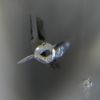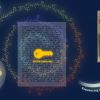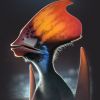-
 +14 +3
+14 +3Red Alert: Massive stars sound warning they are about to go supernova
Astronomers from Liverpool John Moores University and the University of Montpellier have devised an 'early warning' system to sound the alert when a massive star is about to end its life in a supernova explosion. The work was published in Monthly Notices of the Royal Astronomical Society.
-
 +15 +2
+15 +2Researcher discovers another astronomy book written by Galileo Galilei
The process for this discovery started with the revelation that some of Galileo’s documents held at the University of Michigan and at Morgan Library in New York City were in fact counterfeits made by the infamous forger Tobia Nicotra in the early 20th century. Professor Nick Wilding of Georgia State University, who discovered the counterfeit, demonstrated that the filigree of the paper that the texts were written on cannot predate the 18th century.
-
 +15 +2
+15 +2'Wobbling black hole' most extreme example ever detected
Researchers at Cardiff University have identified a peculiar twisting motion in the orbits of two colliding black holes, an exotic phenomenon predicted by Einstein's theory of gravity. Their study, which is published in Nature and led by Professor Mark Hannam, Dr. Charlie Hoy and Dr. Jonathan Thompson, reports that this is the first time this effect, known as precession, has been seen in black holes, where the twisting is 10 billion times faster than in previous observations.
-
 +14 +5
+14 +5‘We’ve Never Seen Anything Like This Before:’ Black Hole Spews Out Material Years After Shredding Star
In October 2018, a small star was ripped to shreds when it wandered too close to a black hole in a galaxy located 665 million light years away from Earth. Though it may sound thrilling, the event did not come as a surprise to astronomers who occasionally witness these violent incidents while scanning the night sky.
-
 +3 +1
+3 +1Ultra Rare Diamond Suggests Earth’s Mantle Has an Ocean’s Worth of Water
A beautiful blue flaw in a gem-quality diamond from Botswana is actually a tiny fragment of Earth’s deep interior—and it suggests our planet’s mantle contains oceans’ worth of water. The flaw, technically called an inclusion, looks like a fish eye: a deep blue center surrounded by a white haze. But it’s really a pocket of the mineral ringwoodite from 660 kilometers down, at the boundary between the upper and lower mantle.
-
 +22 +4
+22 +4Earth is ‘well-hidden’ from extraterrestrial civilizations hunting for habitable planets
Earth is “well-hidden” to extraterrestrial observers using photometric microlensing to hunt for habitable planets that might support life, an international team of researchers has concluded. The findings could also help to narrow down the best areas of the galaxy to target in our own searches for extraterrestrial intelligence (SETI).
-
 +8 +2
+8 +2Fire ant rafts form because of the Cheerios effect, study concludes
Fire ants will change shape of the raft to reduce drag and adapt to fluid flows.
-
 +21 +1
+21 +1Cornea made from pig collagen gives people who were blind 20/20 vision
Corneas made from pig collagen have restored sight for people who were previously legally blind or visually impaired. Two years after the operations, none of the recipients have reported serious complications or adverse side effects.
-
 +4 +1
+4 +1Scientists hid encryption key for Wizard of Oz text in plastic molecules
Scientists from the University of Texas at Austin sent a letter to colleagues in Massachusetts with a secret message: an encryption key to unlock a text file of L. Frank Baum's classic novel The Wonderful Wizard of Oz. The twist: The encryption key was hidden in a special ink laced with polymers, They described their work in a recent paper published in the journal ACS Central Science.
-
 +16 +3
+16 +3The Inventor of Ibuprofen Tested the Drug on His Own Hangover
In retrospect, perhaps toasting the success of a new medication he helped invent with several shots of vodka in Moscow was not a good idea. However, it was too late to go back. English research scientist Stewart Adams was faced with the consequences of his actions: a serious hangover.
-
 +25 +2
+25 +2Blood pressure e-tattoo promises continuous, mobile monitoring
Blood pressure is one of the most important indicators of heart health, but it's tough to frequently and reliably measure outside of a clinical setting. For decades, cuff-based devices that constrict around the arm to give a reading have been the gold standard. But now, researchers at The University of Texas at Austin and Texas A&M University have developed an electronic tattoo that can be worn comfortably on the wrist for hours and deliver continuous blood pressure measurements at an accuracy level exceeding nearly all available options on the market today.
-
 +9 +2
+9 +2These robots were trained on AI. They became racist and sexist.
Researchers trained robots on artificial intelligence exhibited racist and sexist behavior, bringing concerns for the future of automation.
-
 +20 +2
+20 +2Pterosaurs may have had brightly colored feathers on their heads
Pterosaurs not only had feathers, but also were flamboyantly colorful, scientists say. That could mean that feathers — and vibrant displays of mate-seeking plumage — may have originated as far back as the common ancestor of dinosaurs and pterosaurs, during the early Triassic Period around 250 million years ago.
-
 +4 +1
+4 +1Earth-like planets in dead star 'cosmic graveyards' get stranger
The first world found orbiting a pulsar is rarer than previously believed, deepening the mystery of how planets survive around violent dead stars.
-
 +18 +1
+18 +1Fastest known star speeds around Milky Way's black hole at 18 million mph
Astrophysicists have discovered the fastest known star which is racing around the black hole at the center of the Milky Way. The star, designated S4716, completes an orbit around the supermassive black hole Sagittarius A* (Sgr A*) in just around four years.
-
 +3 +1
+3 +1Hubble Space Telescope catches dead star in the act of cosmic cannibalism
The Hubble Space Telescope has spotted evidence of a white dwarf star devouring rocky and icy material from its own system, suggesting that water and other volatiles might be common in the outer reaches of planetary systems.
-
 +21 +2
+21 +2Ground zero for the Black Death finally found after 600 years
The medieval bubonic plague was first recorded in the 14th century.
-
 +13 +3
+13 +3Researcher describes how extraterrestrial civilizations could colonize the galaxy even if they don't have starships
Astronomers have searched for extraterrestrial civilizations in planetary systems for sixty years, to no avail. In the paper published by International Journal of Astrobiology, Cambridge University Press, and titled "Migrating extraterrestrial civilizations and interstellar colonization: Implications for SETI and SETA...
-
 +13 +2
+13 +2Humans may have evolved to show signs of stress to evoke support FROM OTHERS
Showing signs of stress could make us more likeable and prompt others to act more positively towards us, according to a new study by scientists at Nottingham Trent University and the University of Portsmouth.
-
 +21 +3
+21 +3Neptune is cooling down and scientists don't know why
Two decades worth of observations revealed unexpected cooling of the solar system's most distant planet Neptune amid its astronomical summer. Neptune is orbiting 30 times farther away from the sun than Earth with one year lasting 165 Earth years. The ice giant's seasons, too, last much longer than those on Earth — more than 40 Earth-years each.
Submit a link
Start a discussion




















